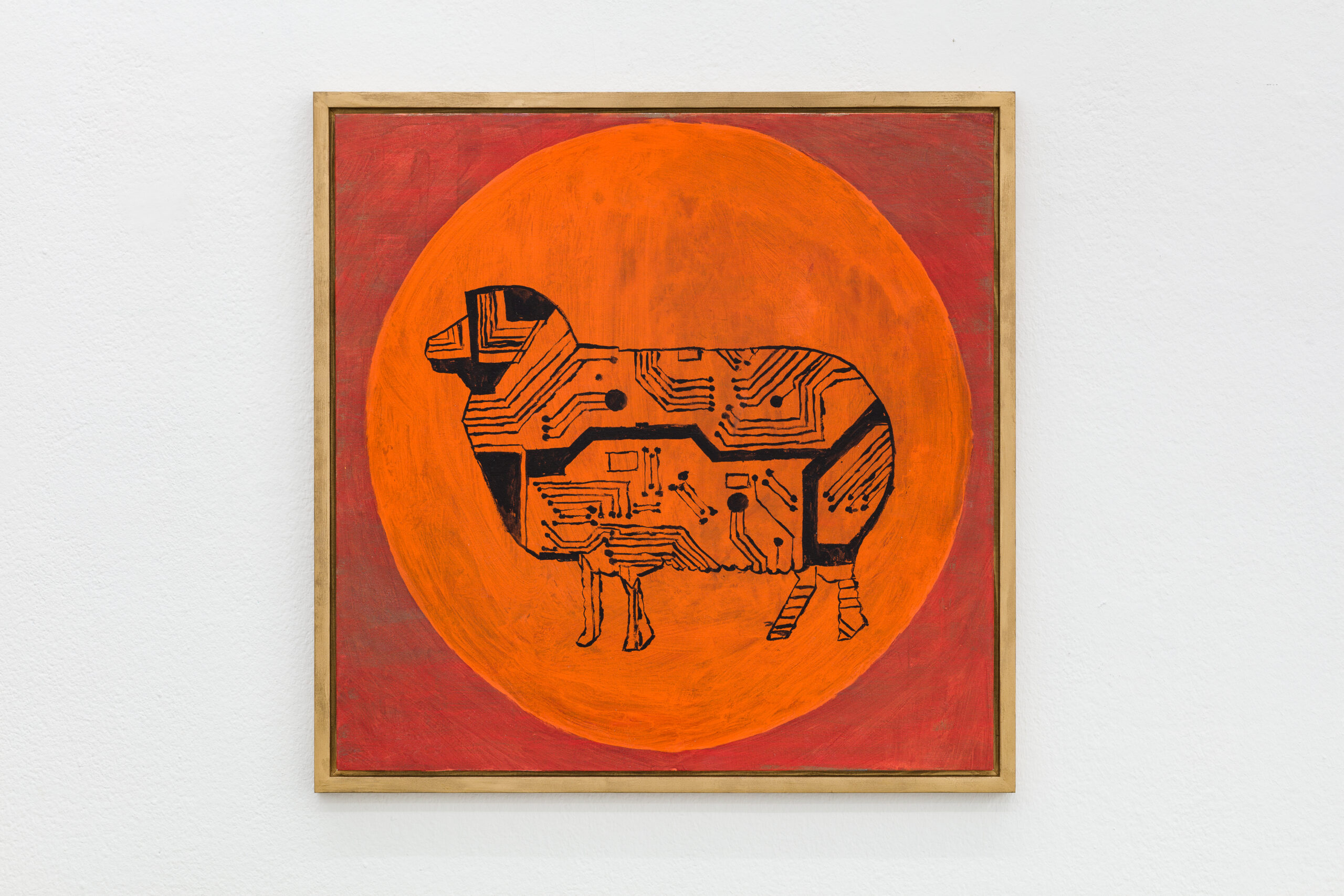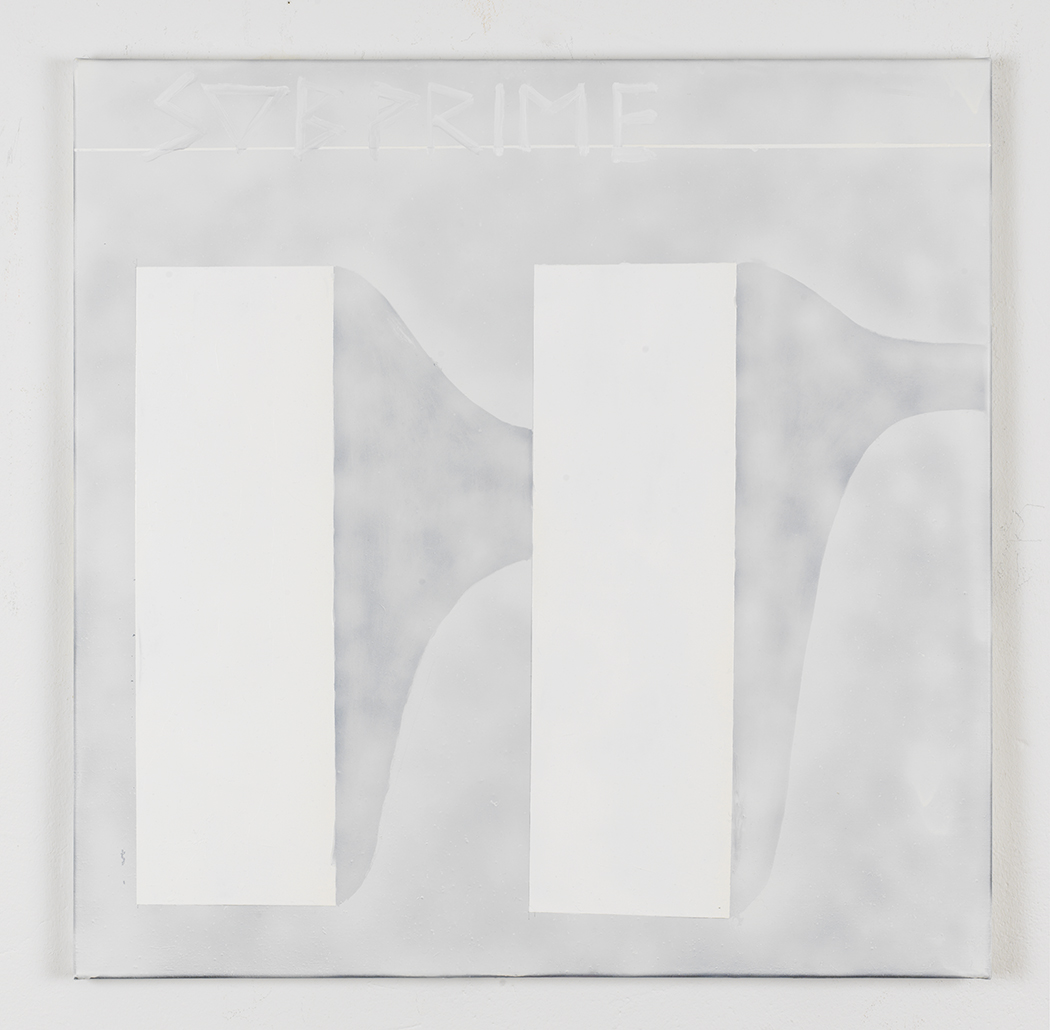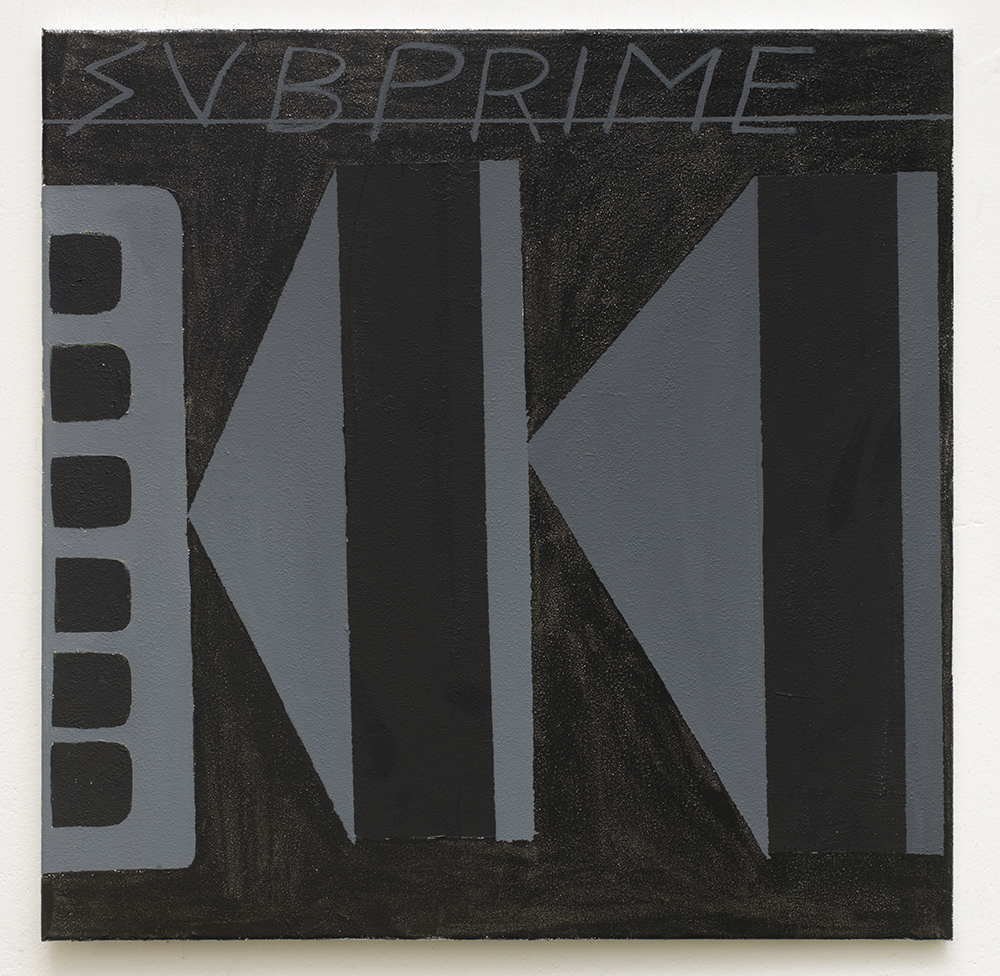
Andy Hope 1930
Esoteric Grandioso, 2021
Acryl und Leuchtfarbe auf Board
60 x 60 cm
Die in dieser Schau erstmals in einer Gruppe gezeigten neun Malereien des Künstlers Andy Hope aus den Jahren 2016-2021 stehen miteinander in enger Verbindung über ein System archaisch-antiker, abstrakt-technoider Zeichen und Bezugnahmen auf die russische Avantgarde.
Gemeinsam bilden sie eine Erzählung über eine Kunst, die Teil eines spekulativen Wertschöpfungsprozesses geworden ist und sich mit ihren eigenen Mitteln gegen die Bedrohung der Entwertung zu wehren weiß.
Wir sehen neun Gemälde in drei Motivgruppen:
a) vier Schafsbilder (A square´s dream I und II, Esoteric Grandioso, Fractale flames)
b) vier abstrakte Gemälde der Subprime-Serie (Subprime I, II, V und VI)
c) eine Roboterdarstellung Empathy x3
„Rabota“ meint im russischen Wortsinn Arbeit. Mechanische Roboter verkörpern den Traum vom stets dienstbaren Arbeitssklaven. Andy Hope verleiht seinem in schwarz und weiß gehaltenen Empathy x3 durch Kugeln froschartigen Züge, was an das Filmungeheuer „Swamp Thing“ erinnern mag, doch eine Kurve in der unteren Bildhälfte prägt dem Roboter das Zeichen einer Schürze ein. Hope rekurriert – wie oft in seiner Karriere – auf seinen historischen Counterpart, den russischen Maler Kasimir Malevitch, in dessen Frühwerk vielfach russische Bäuerinnen auftauchten, bis er sie dann schließlich in der Abstraktion auflöste. Als Malevitch 1915 das berühmte „Rote Quadrat“ schuf, wurde die russische Bäuerin – und mit ihr die Idee der Arbeit – nur noch zum Wortzeichen, das in der Flut des roten Farbauftrags unterging.
Andy Hopes Roboter Empathy x3 aber, mit den folkloristischen, geometrischen Attributen, scheint ein seltsam freundliches Wesen mit vollem Dekolleté zu sein. Aber ist die Empathie nur aufgemalt, nur Zeichen? Besteht das Wesen aus der Summe seiner Teile – aus Referenzen, Gesten, Farben und Materialien – oder ist es mehr als das? Der Autor Philip K. Dick formulierte diese Frage ganz poetisch im Titel seiner berühmten Kurzgeschichte von 1968: Träumen Androiden von elektrischen Schafen?
Andy Hope antwortet darauf indem er das mythologisch höchst aufgeladene Schaf in seine malerische Untersuchung aufnimmt. Er stellt auf dem Bild Esoteric Grandioso einen orangen Kreis in ein leuchtend rotes Quadrat. Im Kreis das Schaf, das über Jahrtausende durch seine Wolle und sein Fleisch den Reichtum oder die Armut eines Menschen anzeigen konnte, und auch nach dem Ende der Stammesgesellschaften ein wichtiges Kulturtier blieb, das für die Herausbildung der Ästhetik ausschlaggebend war. Indem es die Wildnis kahlfraß, ermöglichte es den Blick auf das, was man Landschaft (oder Wirtschaft) nennt.
Andy Hope zeichnet seinen Schafen nun Landschaften der Gegenwart ein.
Tattoohaft, tribalistisch, als wären sie eingeritzt, erinnern die Zeichen an Schaltkreise, Platinen, oder sind es Level früher Computerspiele, gar tiefe Keller?
In diese Zeichen kann geblickt werden als lebten wir noch in der Antike, als sich die Menschen ihre Zukunft aus Schafseingeweiden lesen ließen.
Damit kommen wir zur dritten Bildgruppe, zu Andy Hopes´ Subprime-Serie, die er auch im Jargon des Börsenlexikons als CDO´s bezeichnet (nach collateralized debt obligations), und damit Visualisierungen zu Finanzprodukten der zeitgenössischen Wahrsage- und Vorhersageindustrie mit ihren Kursen liefert.
Subprimes sind Kredite für Kunden mit eingeschränkter Bonität, und die Vergabepraxis in den USA löste in ihrer mathematischen Implausibilität eine weltweite Finanzkrise aus (die Subprime-Krise von 2008/09).
Andy Hope antwortet auf das Wirrspiel der Finanzwirtschaft mit einer verblüffend einfachen Blockform, deren Flucht bzw. Kurve oder Schatten geradezu tröstend aufzeigt, dass die letzte Krise weit im Hintergrund liegt, schwarz wie das Vergessen, braun wie Sand, grau wie Staub. Doch vorne türmt sich die Gegenwart. Der nächste weltweite Kreditausfall? Jedes Bild dieser Serie beurteilt die Lage anders, doch jedes wirkt in seiner Geschlossenheit bedrohlich. Steht der nächste Kollaps bevor? Das Bild Subprime VI ermöglicht sogar einen Blick auf Details, als wäre dies das Muster auf einer aufgefundenen Scherbe.
Andy Hope zeigt mit dieser Schau von neun Gemälden, wie seine Malerei dem Druck der Zeichen, ihrer Bedeutungen und Entwertungen, standhält, und dass sogar Orientierung im Labyrinth möglich ist. Solange ein Quadrat von einem Schaf träumen kann, ist irgendwo ein Ausgang.
– Sarah Khan

Andy Hope 1930
Subprime I, 2016
Lack Sprayfarbe und Öl auf Leinwand
80 x 80 cm

Andy Hope 1930
Subprime VI, 2017
Acryl und Glitter auf Leinwand
80 x 80 x 2,4 cm
The nine paintings produced by artist Andy Hope from 2016-2021 are shown as a group for the first time in this exhibition and are closely linked to one another via a system of archaic-antique, abstract-technoid symbols and references to the Russian avant-garde. Together, they form a narrative about a kind of art that has become part of a speculative process of value creation and which knows, with its own means, how to defend itself against the threat of devaluation.
The nine paintings are grouped into three motifs:
a) four sheep pictures (A square’s dream I and II, Esoteric Grandioso, Fractale flames)
b) four abstract paintings from the Subprime Series (Subprime I, II, V and VI)
c) a depiction of a robot Empathy x3
In Russian, “Rabota” means work. Mechanical robots epitomize the dream of ever subservient work slaves. Due to balls used in Andy Hope’s black and white Empathy x3, the piece is reminiscent of a frog and could also bring to mind the film monster “Swamp Thing”. Yet a curve in the lower half of the image makes the robot appear as if it is wearing an apron. In his career, Hope often refers to his historical counterpart, the Russian painter Kasimir Malevitch, whose early work featured many Russian peasant women, until these finally disappeared in abstraction. When Malevitch created the famous “Red Square” in 1915, the Russian peasant woman – and with her the idea of the work – became little more than a word mark that was drowned in a flood of red paint.
With its folkloric, geometric attributes, Andy Hope’s robot Empathy x3 seems to be a friendly creature though, bearing full cleavage. But is empathy merely painted on, a sign? Is the being the sum of its parts – references, gestures, colours, materials – or is it more? The author Philip K. Dick asked this question poetically in the title of his famous short story from 1968: Do androids dream of electric sheep?
Andy Hope responds to this by including the mythologically highly charged sheep in his investigative painting. His picture Esoteric Grandioso depicts an orange circle in a bright red square. The sheep can be found in the circle, and in its wool and meat, it is able to indicate the wealth or poverty of a person for millennia. Even after the end of tribal societies, the sheep remained an important cultural animal that also proved decisive for the development of aesthetics. By grazing away the wilderness, it made visible what we call the landscape (or economy).
Andy Hope now draws contemporary landscapes into his sheep.
Tattoo-like and tribalistic, as if they were carved, the images are reminiscent of circuits and circuit boards, or perhaps early computer game levels, or even deep basements.
One might look at these images, as people did who lived in antiquity, when their futures were read from sheep’s entrails.
This brings us to the third group of images, Andy Hopes’ Subprime series, which he also calls CDOs in the jargon of the stock exchange lexicon (after collateralized debt obligations). With this series, he provides visualizations of contemporary fortune telling and prediction industry financial products. Subprimes are loans for customers with limited creditworthiness, and the USA’s mathematically implausible lending practices triggered a global financial crisis (the subprime crisis of 2008/09).
In response to the confusion associated with the financial economy, Andy Hope has created an astonishingly simple block shape, whose curve or shadow consolingly illustrates how far back the last crisis already lies. As black as oblivion, as brown as sand, as grey as dust. Yet the present is building up in front. Could it signal the next global loan default? Each picture in this series assesses the situation differently, yet each one also seems threatening in its unity. Is the next collapse imminent? The image Subprime VI even allows viewers to peer at details as if these were patterns on a found shard.
With this exhibition of nine paintings, Andy Hope shows how his art can withstand the pressure of signs, as well as their meanings and devaluations. His work also shows that orientation is possible in the labyrinth. So long as a square can dream of a sheep, an exit exists somewhere.
– Sarah Khan









